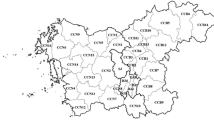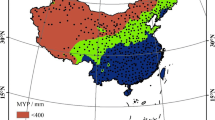Abstract
Continuous and accurate drought monitoring has an important role in early warning drought mitigation policies. This study aims to provide an accurate standardized drought monitoring indicator by enhancing the representative characteristics of precipitation data using advanced statistical methods. We proposed a two-phase statistical procedure index – the Regional Multi-Component Gaussian Hydrological Drought Assessment (RMcGHDA) – for accurate drought monitoring under a multi-auxiliary variable-based sampling estimator and K-Component Gaussian Mixture Distribution (CGMD) model. The first phase of our proposed method increases the regional representativeness of the data under Spatio-temporal settings and the second phase describes the use of the Twelve-Component Gaussian Mixture Distribution (CGMD) model in the standardization stage of SDIs. We applied the proposed framework to 52 meteorological stations in Pakistan and compared the RMcGHDA performance with existing methods using Pearson correlation (r) and spatial patterns of various drought categories. We found significant differences between RMcGHDA and existing methods (i.e., Standardized Precipitation Index (SPI) and Standardized Precipitation Evapotranspiration Index (SPEI)) for drought assessment. By the rationale of the data improvement under-sampling estimator and the use of multi-component Gaussian function, these differences indicate that RMcGHDA provides a practical and accurate way for drought assessment.







Similar content being viewed by others
Data Availability
All the data were analyzed using R software. The data and code used to support the findings of this study are available from the corresponding author upon request.
References
Abu-Dayyeh WA, Ahmed MS, Ahmed RA, Muttlak HA (2003) Some estimators of a finite population mean using auxiliary information. Appl Math Comput 139(2–3):287–298
Ali Z, Hussain I, Faisal M, Nazir HM, Abd-el Moemen M, Hussain T, Shamsuddin S (2017) A novel multi-scalar drought index for monitoring drought: the standardized precipitation temperature index. Water Resour Manage 31(15):4957–4969
Ali Z, Hussain I, Faisal M, Almanjahie IM, Ahmad I, Khan DM, Qamar S (2019a) A probabilistic weighted joint aggregative drought index (PWJADI) criterion for drought monitoring systems. Tellus A: Dyn Meteorol Oceanogr 71(1):1588584
Ali Z, Hussain I, Faisal M, Grzegorczyk MA, Almanjahie IM, Nazeer A, Ahmad I (2019b) Characterization of regional hydrological drought using improved precipitation records under multi-auxiliary information. Theor Appl Climatol 1–12
Ali F, Li BZ, Ali Z (2021) Strengthening drought monitoring module by ensembling auxiliary information based varying estimators. Water Resour Manage 1–18. https://doi.org/10.1007/s11269-021-02888-2
Bazrafshan J, Hejabi S, Rahimi J (2014) Drought monitoring using the multivariate standardized precipitation index (MSPI). Water Resour Manage 28(4):1045–1060
Benaglia T, Chauveau D, Hunter D, Young D (2009) Mixtools: an R package for analyzing finite mixture models
Carfagna F, Cervigni R, Fallavier P (Eds.) (2018) Mitigating Drought Impacts in Drylands: Quantifying the Potential for Strengthening Crop-and Livestock-Based Livelihoods. The World Bank
Cochran WG (2007) Sampling techniques. John Wiley & Sons
Deacon C, Samways MJ, Pryke JS (2019) Aquatic insects decline in abundance and occupy low-quality artificial habitats to survive hydrological droughts. Freshw Biol 64(9):1643–1654
Duan H, Wang X, He X, He Y, Song L, Nie S (2020) Feature selection based on gaussian mixture model clustering for the classification of pulmonary nodules based on computed tomography. J Med Imaging Health Inform 10(5):1033–1039
Erhardt TM, Czado C (2017) Standardized drought indices: a novel univariate and multivariate approach. R Stat Soc 67(3):643–664
Estevao VM, Sarndal C (1999) The use of auxiliary information in design-based estimation for domains. Surv Methodol 25(2):213–221
Jiang H, Khan MA, Li Z, Ali Z, Ali F, Gul S (2020) Regional drought assessment using improved precipitation records under auxiliary information. Tellus A: Dyn Meteorol Oceanogr 72(1):1–26
Kang H, Sridhar V, Mills BF, Hession WC, Ogejo JA (2019) Economy-wide climate change impacts on green water droughts based on the hydrologic simulations. Agric Syst 171:76–88
Koyuncu N, Kadilar C (2009) Family of estimators of population mean using two auxiliary variables in stratified random sampling. Commun Stat Theory Methods 38(14):2398–2417
Lu J (2013) The chain ratio estimator and regression estimator with linear combination of two auxiliary variables. Plos One 8(11):e81085
McKee TB, Doesken NJ, Kleist J (1993) The relationship of drought frequency and duration to time scales. In: Proceedings of the 8th Conference on Applied Climatology, vol 17, no. 22, pp 179–183
McLachlan GJ, Chang SU (2004) Mixture modelling for cluster analysis. Stat Methods Med Res 13(5):347–361
Muili JO, Audu A, Odeyale AB, Olawoyin IO (2019) Ratio estimators for estimating population mean using tri-mean, median and quartile deviation of auxiliary variable. J Sci Technol Res 1(1):91–102
Park J, Sung JH, Lim YJ, Kang HS (2019) Introduction and application of non-stationary standardized precipitation index considering probability distribution function and return period. Theoret Appl Climatol 136(1):529–542
Robson DS (1957) Applications of multivariate polykays to the theory of unbiased ratio-type estimation. J Am Stat Assoc 52(280):511–522
Rosenfeld D, Lohmann U, Raga GB, O’Dowd CD, Kulmala M, Fuzzi S, Andreae MO (2008) Flood or drought: how do aerosols affect precipitation? Science 321(5894):1309–1313
Samantaray AK, Singh G, Ramadas M, Panda RK (2019) Drought hotspot analysis and risk assessment using probabilistic drought monitoring and severity–duration–frequency analysis. Hydrol Process 33(3):432–449
Santillán-Fernández A, Santoyo-Cortés VH, García-Chávez LR, Covarrubias-Gutiérrez I, Merino A (2016) Influence of drought and irrigation on sugarcane yields in different agroecoregions in Mexico. Agric Syst 143:126–135
Shekofteh Y, Panahi S, Boubaker O, Jafari S (2019) Parameter estimation of chaotic systems using density estimation of strange attractors in the State space. In: Recent Advances in Chaotic Systems and Synchronization, Academic Press, pp 105–124
Siebert J, Sünnemann M, Auge H, Berger S, Cesarz S, Ciobanu M, Eisenhauer N (2019) The effects of drought and nutrient addition on soil organisms vary across taxonomic groups, but are constant across seasons. Sci Rep 9(1):1–12
Singh HP, Solanki RS (2012) An efficient class of estimators for the population mean using auxiliary information in systematic sampling. J Stat Theory and Pract 6(2):274–285
Solanki RS, Singh HP, Pal SK (2013) Improved estimation of finite population mean in sample surveys. J Adv Com 1(2):70–78
Tang D, Wei F, Qin S, Khan A, Kashif MH, Zhou R (2019) Polyethylene glycol induced drought stress strongly influences seed germination, root morphology and cytoplasm of different kenaf genotypes. Ind Crops Prod 137:180–186
Tóth BG, Rácz II, Horváth I (2019) Gaussian-mixture-model-based cluster analysis of gamma-ray bursts in the BATSE catalog. Mon Not R Astron Soc 486(4):4823–4828
Verma HK, Sharma P, Singh R (2015) Some families of estimators using two auxiliary variables in stratified random sampling. Investigación Oper 36(2):140–150
Vicente-Serrano SM, Beguería S, López-Moreno JI (2010) A multiscalar drought index sensitive to global warming: the standardized precipitation evapotranspiration index. J Clim 23(7):1696–1718
Vishwakarma GK, Kumar M (2015) An efficient class of estimators for the mean of a finite population in two-phase sampling using multi-auxiliary variates. Commun Math Stat 3(4):477–489
Watson DJ (1937) The Estimation of Leaf Areas. J Agri Sci 27:474. https://doi.org/10.1017/S002185960005173
World Meteorological Organization (2012) Standardized precipitation index user guide. World Meteorol Org 1090
Acknowledgements
The authors are thankful to Karachi Data Processing Center (KDPC), Pakistan Meteorological Department, for providing the data. Further, the extended their appreciation to Mr. Abdul Salam, (Ph.D. candidate at Bernoulli Institute for Mathematics, Computer Science and Artificial Intelligence, University of Groningen, Netherlands) for their valuable comments to improve the manuscript.
Funding
The authors are very grateful to the China Huaneng Group Co., Ltd., for the financial support through the Project (HNKJ17-H20).
Author information
Authors and Affiliations
Contributions
All authors have equal contribution.
Corresponding author
Ethics declarations
Ethics Approval
The manuscript is prepared in accordance with the ethical standards of the responsible committee on human experimentation and with the latest (2008) version of Helsinki Declaration of 1975.
Consent to Participate
Not applicable.
Consent for Publication
Not applicable.
Competing Interests
The authors declare that they have no competing interests.
Additional information
Publisher's Note
Springer Nature remains neutral with regard to jurisdictional claims in published maps and institutional affiliations.
Rights and permissions
About this article
Cite this article
Ali, Z., Ellahi, A., Hussain, I. et al. Reduction of Errors in Hydrological Drought Monitoring – A Novel Statistical Framework for Spatio-Temporal Assessment of Drought. Water Resour Manage 35, 4363–4380 (2021). https://doi.org/10.1007/s11269-021-02952-x
Received:
Accepted:
Published:
Issue Date:
DOI: https://doi.org/10.1007/s11269-021-02952-x




